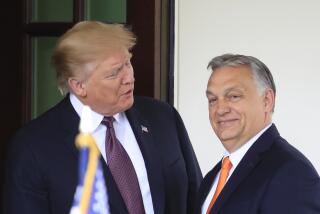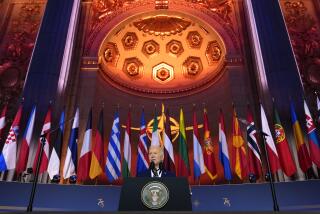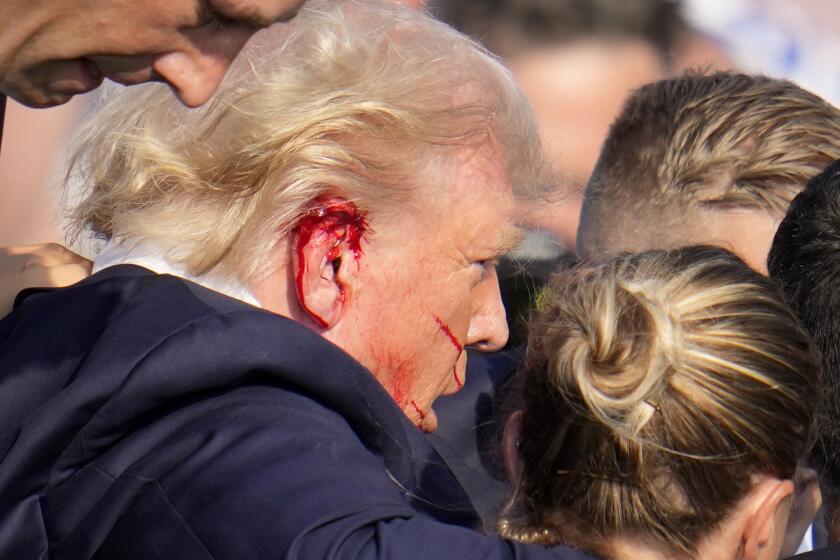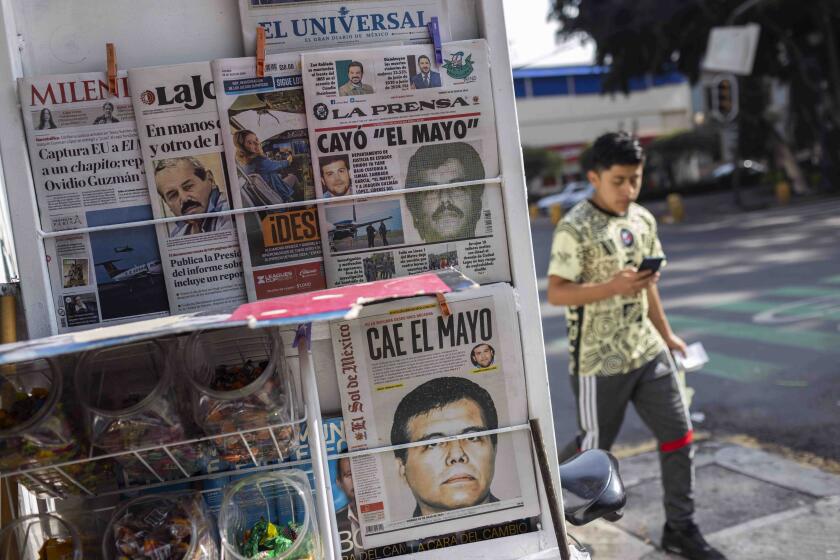What’s in a name? Poland tempts Trump with deal to build permanent military base for U.S. troops
It’s a blockbuster Polish real estate deal, structured to tempt a certain former Manhattan developer who affixes his name to all his properties.
Poland is offering President Trump as much as $2 billion and a long-term lease in an “ideal location” if the United States will build a permanent military base there. But that’s not all: Polish President Andrzej Duda suggested only half-jokingly earlier this month at the White House that the complex should be named “Fort Trump.”
For the record:
1:45 p.m. Sept. 29, 2018An earlier version of this article misspelled Polish lawmaker Anna Maria Anders’ name as Anna Marie Anders, and U.S. Army Gen. Curtis “Mike” Scaparrotti’s name was misspelled as Mike Scaparotti.
Bypassing the Pentagon and its allies in NATO, Poland is making a naked appeal directly to the man who could seal the deal. But the offer is vexing other nations in the 29-member NATO alliance, who already are reeling from Trump’s repeated broadsides against members who fail to meet self-imposed military spending targets.
Poland’s defense minister, Mariusz Blaszczak, alluded to the internal divisions during a high-level meeting of NATO’s Military Committee here on Saturday, saying he was pleased that the Trump administration “has started an evaluation of a permanent presence in Poland,” and hoped “the idea would be supported” by the alliance.
For Poland, which has been invaded and carved up repeatedly during its history by Russia and Germany, a major U.S. base is seen as its best long-term guarantee of security.
But Germany, one of Trump’s favorite targets, is wary of the Polish offer, alliance officials say. It fears the proposed base would prompt the U.S. to shift troops and shrink bases that Germany has hosted for decades and also antagonize Russia, which is building an offshore gas pipeline to northern Germany that Trump opposes.
“This would be seen by everybody as the president punishing our German allies and I think that would be a major mistake,” said U.S. Army Lt. Gen. Ben Hodges, who commanded U.S. troops in Europe before retiring this year, in an interview.
Despite Poland’s cash offer, most of the costs would likely be borne by U.S. taxpayers, officials said. A large new base requiring construction of headquarters buildings, barracks, airfields, training ranges, family housing, roads and rail lines — all of which already exist in Germany and other NATO countries to the west — may not be practical, according to Defense Secretary James N. Mattis.
“Right now, I’m not willing to say we need it,” Mattis said earlier this week, calling the talks with the Poles “exploratory” and warning that a U.S. base in Poland “has an impact on the alliance as a whole.”
It would significantly raise tensions with Moscow, which has long warned the U.S. against establishing permanent installations nearer its border in the countries, such as Poland, that it occupied during the Cold War.
But Trump has said he is considering the Polish proposal “very seriously.” He contrasted Warsaw’s cash offer with the record of other allies, whom he regularly — and often inaccurately — blames for failing to pay for U.S. military protection.
The president’s support seemingly stems in part from his affection both for Poland, where he was wildly cheered during a visit last year, and for Duda, whose populist, anti-immigration politics closely track his own.
“Mr. Trump is saying ‘America first’ and I’m saying ‘Poland first.’ So we understand each other very well,” Duda said when he appeared beside Trump in the Oval Office meeting.
Stationing U.S. troops closer to Russia would run counter to Trump’s goal of easing tensions with Moscow, which would almost certainly respond by stationing troops in neighboring Belarus. That in turn would raise tensions not only with Latvia, Lithuania and Estonia, which are also NATO members, but with Poland as well.
But Poland is playing on Trump’s antipathy for Germany, where the majority of the 35,000 U.S. troops in Europe are now based. Though Trump defers to his Pentagon advisors on most issues, he has overruled them on matters that strike a personal chord, leading some to worry he might jump at the Polish proposal.
“My concern is that the U.S. might make a decision to do this without consulting our other allies,” said Hodges, the retired Army commander. “I don’t know if that necessarily helps improve security for anybody.”
If troops for a base in Poland do not come from Germany, Congress would have to vote to increase the size of the Army or take troops from bases in Texas, Colorado or Kansas that host large combat units.
“There’s no congressional delegation in Congress that would support” shrinking its home-state base to send troops to Poland, Hodges said.
NATO is already contending with concerns about whether Germany, France or the United States would come to the aid of newer, more vulnerable NATO members in Central Europe if war broke out with Russia — fears that have grown with Trump’s repeated attacks on the alliance as something of a burden for his country.
Stationing a U.S. armored division, with as many as 20,000 troops, tanks, attack helicopters and artillery near Poland’s so-called Sawalki Gap — a 65-mile corridor in northeast Poland separating Russian ally Belarus and the Russian enclave of Kaliningrad — would ensure sufficient forces are nearby in case of any military moves by Moscow, Polish officials say.
Though NATO and the U.S. have been building up their military presence in Central Europe in recent years, current plans still call for rushing reinforcements and equipment from Germany, Italy or even the United States if war breaks out.
U.S. Army Gen. Curtis “Mike” Scaparrotti, the supreme allied commander for both NATO and U.S. troops in Europe, said in an interview Saturday that the alliance had improved its ability to move reinforcements quickly, suggesting the alliance’s broader needs might outweigh Poland’s desire for more troops.
“We’re looking at what is the best response for this offer,” he said. “I have to look at it in a holistic way.”
Despite Duda’s very public stroking of Trump’s well-known ego, some Polish officials concede that the plan could be scuttled by opposition from other alliance members and by a price tag expected to far exceed Warsaw’s $2-billion offer.
“Regular people on the street have been hyped up to believe that President Trump is simply going to say yes and it’s going to happen,” said Anna Maria Anders, a Polish senator and the country’s secretary of state for international dialogue. “But I’m not sure other NATO countries are for it and it’s certainly not a done deal.”
The U.S. already keeps more than 3,000 troops in Poland under NATO’s reinforcement of the alliance’s eastern flank following Russia’s 2014 annexation of Ukraine’s Crimean peninsula. But the Pentagon rotates U.S.-based units in and out, keeping alive the commitment not to permanently base forces in the former Soviet zone.
The rotations, which brought over 16,000 U.S. troops to Poland last year, are part of the Pentagon’s so-called European Reassurance Initiative that will spend $6.5 billion this year to allay doubts about whether the U.S. would defend the alliance’s eastern flank.
Few expect Russia to start a conventional war anytime soon against a NATO member. It could, however, step up unconventional tactics. In recent years it has backed separatists in eastern Ukraine, allegedly attacked individuals with a deadly nerve agent in Britain, and sought to disrupt elections in the U.S. and European countries using cyber misinformation and propaganda.
Besides troop rotations in Poland, the United States is also building an $800-million missile defense battery near the Polish town of Redzikowo, near the Baltic Sea, though construction delays have pushed completion to 2020. Poland also recently signed a separate $4.75-billion agreement to buy a U.S. Patriot missile defense system, a deal Trump hailed in his meeting with Duda.
But Poland, which joined NATO in 1999 in the alliance’s first post-Cold War expansion, says it wants more American military might.
A 39-page proposal by its defense ministry asks for an entire armored U.S. division, amounting to 15,000 to 20,000 troops along with families and support personnel. It recommends that the base be situated near the cities of Bydgoszcz or Torun, in northwest Poland, where NATO has a small training facility.
That’s 700 miles east from Stuttgart, Germany, where the U.S. European Command is.
“A permanent U.S. presence in Poland, a more forward operating location than Stuttgart provides, would greatly alleviate well-founded fears that fellow Eastern European and Baltic governments have that Moscow would be able to overtake defending forces” before the U.S. could rush reinforcements to Poland, the document says.
There’s little chance such a base would be named “Fort Trump,” at least not formally. Nor is it likely that it would get an entire division, which is more ground combat power than the U.S. now keeps in all of Europe.
Other enticements described by the Poles, including tax waivers, long-term leases and promised infrastructure construction, appear to differ little from those agreed to for decades by the German government to defray U.S. base costs. But Poland insists it is prepared “to offer great flexibility” on the deal — a promise Trump may have a hard time resisting.
Twitter: @davidcloudLAT
More to Read
Sign up for Essential California
The most important California stories and recommendations in your inbox every morning.
You may occasionally receive promotional content from the Los Angeles Times.






